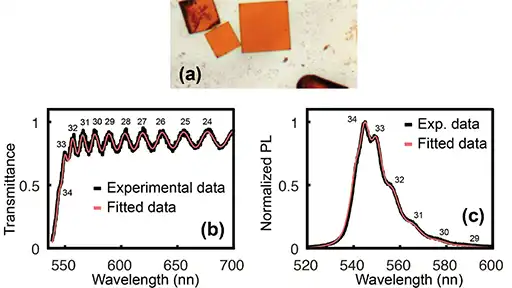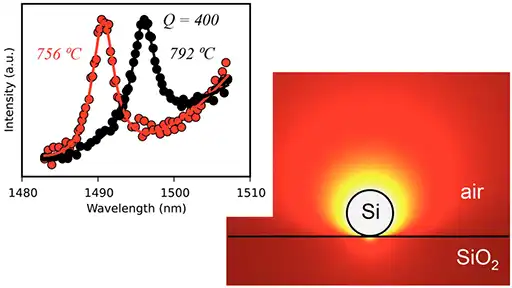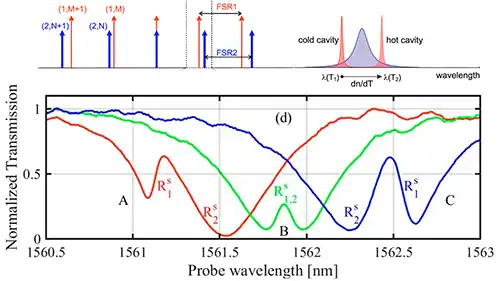


Silicon microspheres with a diameter in the range of 2–3 micrometers constitute photonic nanocavities that emit light through their Mie resonances when heated at high temperatures. At 500–600 °C these microresonators show a particular mid-infrared (MIR) emission dominated by the lowest order modes. Such resonances feature a large free spectral range, about 600 cm−1, and a high proximity to the critical coupling condition. In fact, resonances with high-quality factor, around 160 are found. It corresponds to the limit of detection of their measuring setup, being 600 the theoretical value. Most importantly, several modes emit light above the calculated black body limit because they feature an optical absorption cross-section larger than their geometric one. All these characteristics set silicon microspheres as very promising zero-dimensional materials for developing micrometric and sub-wavelength light sources in the MIR.

Supporting information with additional figures and explanations.

We make use of a phase-sensitive set-up to study the light transmission through a coupled waveguide-microdisk system. We observe a splitting of the transmission resonance leading to an unbalanced doublet of dips. The experimental data are analyzed by using a phasor diagram that correlates the real and the imaginary parts of the complex transmission. In addition, detailed features are evidenced by a complex inverse representation of the data that maps ideal resonances into straight lines and split resonances into complicated curves. Modeling with finite element method simulations suggests that the splitting and the unbalance is caused by an induced chirality in the propagation of the optical fields in the microdisk due to the interplay between the stochastic roughness and the intermodal dissipative coupling, which yield an asymmetric behavior. An analytical model based on the temporal coupled mode theory shows that both a reactive and a dissipative coupling of the counter-propagating modes by the surface roughness of the ring resonator are required to quantitatively reproduce the experimental observations and the numerical simulations.

We study light transmission and reflection from an integrated microresonator device, formed by a circular microresonator coupled to a bus waveguide, with an embedded S-shaped additional crossover waveguide element that selectively couples counter-propagating modes in a propagation-direction-dependent way. The overall shape of the device resembles a “taiji” symbol, hence its name. While Lorentz reciprocity is preserved in transmission, the peculiar geometry allows us to exploit the non-Hermitian nature of the system to obtain high-contrast uni- directional reflection with negligible reflection for light incident in one direction and a significant reflection in the opposite direction.

A precise knowledge of the optical properties, specifically the refractive index, of organic/inorganic perovskites, is essential for pushing forward the performance of the current photovoltaic devices that are being developed from these materials. Here we show a robust method for determining the real and the imaginary part of the refractive index of MAPbBr3 thin films and micrometer size single crystals with planar geometry. The simultaneous fit of both the optical transmittance and the photoluminescence spectra to theoretical models defines unambiguously the refractive index and the crystal thickness. Because the method relies on the optical resonance phenomenon occurring in these microstructures, it can be used to further develop optical microcavities from perovskites or from other optical materials.

Planck’s law constitutes one of the cornerstones in physics. It explains the well-known spectrum of an ideal blackbody consisting of a smooth curve, whose peak wavelength and intensity depend on the temperature of the body. This scenario changes drastically, however,
when the size of the emitting object is comparable to the wavelength of the emitted radiation. Here we show that a silicon microsphere (2−3 μm in diameter) heated to around 800 °C yields a thermal emission spectrum consisting of pronounced peaks that are associated with Mie resonances. We experimentally demonstrate in the near-infrared the existence of modes with an ultrahigh quality factor, Q, of 400, which is substantially higher than values reported so far, and set a new benchmark in the field of thermal emission. Simulations predict that the thermal response of the microspheres is very fast, about 15 μs. Additionally, the possibility of achieving light emission above the Planck limit at some frequency ranges is envisaged.

We report on the modeling, simulation, and experimental demonstration of complete mode crossings of Fano resonances within chip-integrated microresonators. The continuous reshaping of resonant line shapes is achieved via nonlinear thermo-optical tuning when the cavity-coupled optical pump is partially absorbed by the material. The locally generated heat then produces a thermal field, which influences the spatially overlapping optical modes, allowing us to alter the relative spectral separation of resonances. Furthermore, we exploit such tunability to continuously probe the coupling between different families of quasi-degenerate modes that exhibit asymmetric Fano interactions. As a particular case, we demonstrate a complete disappearance of one of the modal features in the transmission spectrum as predicted by Fano [Phys. Rev. 124, 1866 (1961)]. The phenomenon is modeled as a third-order nonlinearity with a spatial distribution that depends on the stored optical field and thermal diffusion within the resonator. The performed nonlinear numerical simulations are in excellent agreement with the exper- imental results, which confirm the validity of the developed theory.